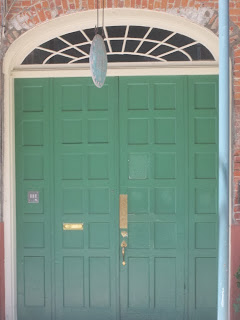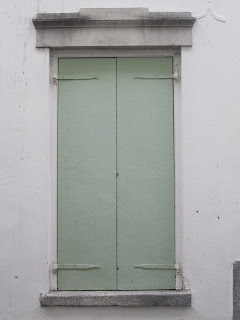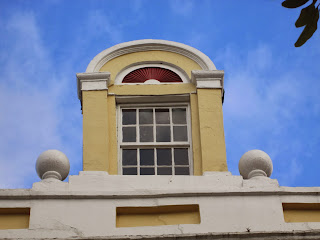Detail of the carved front door surround at The Hermann-Grima historic house museum in the French Quarter of New Orleans, Louisiana. William Brand designed and built the house in the Federal or Georgian style in 1831.
I delight in beautiful historic details! Often historic building of great age have been modified over time. Bubbled wavy glass is replaced with new glass. Hand carved wood details rot away and are replaced with new growth uncarved wood. Bricks can be altered. Historic buildings are added to and made smaller in size. It is not often that we can look at a historic building of great age and see much of a building from the time period it was built. That's why historic original details are a delight. Today we take a tour of some of my favorite historic details in New Orleans French Quarter, also known as the Vieux Carré, is the oldest neighborhood in the city of New Orleans. When New Orleans (La Nouvelle-Orléans in French) was founded in 1718 by Jean-Baptiste Le Moyne de Bienville, the city was originally centered on the French Quarter. Today the French Quarter is a treasure trove of Historic buildings dating from the 18th century to the early 20th century. Here are some of their details!
Detail of the carved front door surround at The Hermann-Grima historic house museum in the French Quarter of New Orleans, Louisiana. William Brand designed and built the house in the Federal or Georgian style in 1831.
Front door surround at The Hermann-Grima historic house museum in the French Quarter of New Orleans, Louisiana. William Brand designed and built the house in the Federal or Georgian style in 1831.
Detail of 18th century bricks fro a building that was on the property before the house was built at The Hermann-Grima historic house museum in the French Quarter of New Orleans, Louisiana. William Brand designed and built the house in the Federal or Georgian style in 1831.
Fanlight French doorway on a 18th century French Quarter mansion
Beautiful 18th century transom and French door on Royal street
Detail of 18th century transom
Detail of wrought iron brackets and balcony at the Old Absinthe House built 1806. Many celebrities have been welcomed through our doors in the nearly two centuries since its opening -- including Oscar Wilde, P.T. Barnum, Mark Twain, Jenny Lind, Enrico Caruso, General Robert E Lee, Franklin Roosevelt, Liza Minelli and Frank Sinatra.
Detail of wrought iron balcony and detailed stucco work at the Old Absinthe House built 1806
French doorway at the Old Absinthe House built 1806
Detail of wrought iron balcony Old Absinthe House built 1806
Royal street doorway and interesting transom
French Quarter patina
late 18th century wrought iron balcony and bracket
Nice early 19th century Federal dormer
Greek Revival cast iron
Terracotta tiles
18th century wrought iron gate
Greek Revival classical cast iron downspout
Detail of downspout
Greek Revival egg and dart and lambs tongue molding
Gas light
Greek Revival door
1791 intricate decorative stucco work
Greek Revival door and classical wrought and cast iron
Greek Revival wrought iron and alley lintel
Greek Revival egg and dart and lambs tongue molding
Classical wrought iron
Greek Revival cast iron and egg and dart and lambs tongue molding
Classical cast iron
Federal doorway
Doorway of The Beauregard-Keyes House, built in 1826 for wealthy auctioneer Joseph LeCarpentier, is a fine example of a raised center hall house. It is named for two of its former residents, Confederate General Pierre Gustave Toutant (P.G.T.) Beauregard and author Frances Parkinson Keyes.
Doorway of the Soniat house built in 1830 by Joseph Soniat, a plantation owner who needed a house in New Orleans when visiting with his large family.
Rare French Quarter transom
Temple of the winds capital
Greek Revival Granite doorway
Wrought iron balcony
Greek Revival window with iron shutters
Detail of Greek Revival doorway
Detail of Greek Revival doorway
Detail of Greek Revival doorway
Lyre classical wrought iron balcony
Court of Two Lions in the French Quarter of New Orleans at 708 Toulouse Street. Built in 1798 by Don Juan Mericult. Gate to courtyard with two facing lions.
Detail of decorative stucco work on the house of the Court of Two Lions in the French Quarter of New Orleans at 708 Toulouse Street. Built in 1798 by Don Juan Mericult. Gate to courtyard with two facing lions.
French Quarter iron
Decorative wrought iron
18th century stucco work
18th century stucco work
18th century wrought iron
Corinthian cast iron column
Detail of cast & wrought iron on the Bank of Louisiana building 1826
Detail of cast & wrought iron on the Bank of Louisiana building 1826
Detail of a 1868 Italianate Cast-iron building in the French Quarter
Detail of a 1868 Italianate Cast-iron building in the French Quarter
Detail of a 1868 Italianate Cast-iron building in the French Quarter
Creole townhouse circa 1800 built by Barthelemy Lafon for Vincent Rillieux the great grandfather of Edgar Dagas
the Rillieux-Waldhorn House, this is now the home of Waldhorn Antiques (est. 1881). The building was built between 1795 and 1800 for Vincent Rillieux, the great-grandfather of the French Impressionist artist Edgar Degas. Offices of the (second) Bank of the United States occupied the building from 1820 until 1836 when, thanks to President Andrew Jackson's famous veto, its charter expired. Note the wrought-iron balconies -- an example of excellent Spanish colonial workmanship.
Dormer on the Louisiana State Bank Building 1821 It was the last structure designed by nationally prominent architect Benjamin H. Latrobe, who died from yellow fever in New Orleans.
Immediately, adjoining the old Louisiana State Bank Building, 409 Royal Street, is a much older structure, that for eight years was the town house of Jean Blanque, once a well-known figure in old New Orleans. Merchant, lawyer, banker, and legislator.
Doorway and wrought iron on the Old Brulatour Mansion at 520 Royal Street 1819
Wrought iron on the Old Brulatour Mansion at 520 Royal Street 1819
wrought iron bracket on the Old Brulatour Mansion at 520 Royal Street 1819
Carved cypress cornice
Classical wrought iron
Classical wrought iron
Greek Revival doorway on Bourbon street
Greek Revival doorway on Bourbon street
18th century capital
Cast iron water god head
Detail of Greek Revival window transom
Detail of Greek Revival window transom
Greek Revival portico
Greek Revival cast iron
Greek Revival egg and dart and lambs tongue molding
Greek Revival window
Greek Revival egg and dart and lambs tongue molding
Greek Revival cast iron
Ornate cast iron








































































































Wow, all so beautiful!
ReplyDelete